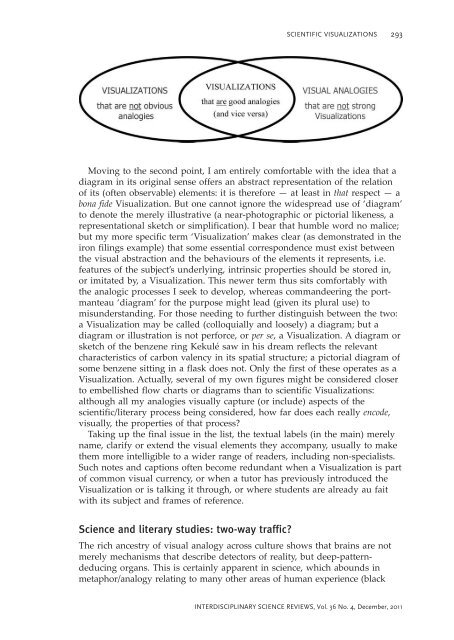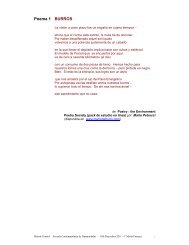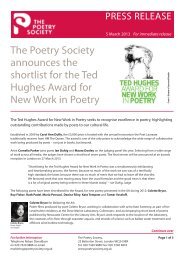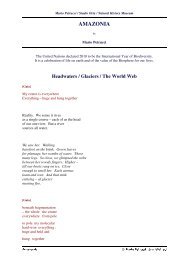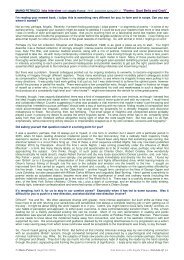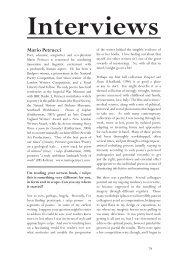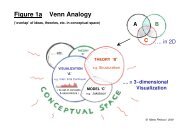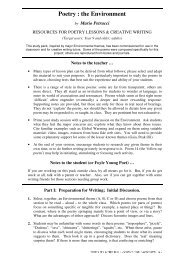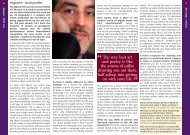Scientific Visualizations: Bridge-Building between ... - Mario Petrucci
Scientific Visualizations: Bridge-Building between ... - Mario Petrucci
Scientific Visualizations: Bridge-Building between ... - Mario Petrucci
You also want an ePaper? Increase the reach of your titles
YUMPU automatically turns print PDFs into web optimized ePapers that Google loves.
SCIENTIFIC VISUALIZATIONS<br />
293<br />
Moving to the second point, I am entirely comfortable with the idea that a<br />
diagram in its original sense offers an abstract representation of the relation<br />
of its (often observable) elements: it is therefore — at least in that respect — a<br />
bona fide Visualization. But one cannot ignore the widespread use of ‘diagram’<br />
to denote the merely illustrative (a near-photographic or pictorial likeness, a<br />
representational sketch or simplification). I bear that humble word no malice;<br />
but my more specific term ‘Visualization’ makes clear (as demonstrated in the<br />
iron filings example) that some essential correspondence must exist <strong>between</strong><br />
the visual abstraction and the behaviours of the elements it represents, i.e.<br />
features of the subject’s underlying, intrinsic properties should be stored in,<br />
or imitated by, a Visualization. This newer term thus sits comfortably with<br />
the analogic processes I seek to develop, whereas commandeering the portmanteau<br />
‘diagram’ for the purpose might lead (given its plural use) to<br />
misunderstanding. For those needing to further distinguish <strong>between</strong> the two:<br />
a Visualization may be called (colloquially and loosely) a diagram; but a<br />
diagram or illustration is not perforce, or per se, a Visualization. A diagram or<br />
sketch of the benzene ring Kekulé saw in his dream reflects the relevant<br />
characteristics of carbon valency in its spatial structure; a pictorial diagram of<br />
some benzene sitting in a flask does not. Only the first of these operates as a<br />
Visualization. Actually, several of my own figures might be considered closer<br />
to embellished flow charts or diagrams than to scientific <strong>Visualizations</strong>:<br />
although all my analogies visually capture (or include) aspects of the<br />
scientific/literary process being considered, how far does each really encode,<br />
visually, the properties of that process?<br />
Taking up the final issue in the list, the textual labels (in the main) merely<br />
name, clarify or extend the visual elements they accompany, usually to make<br />
them more intelligible to a wider range of readers, including non-specialists.<br />
Such notes and captions often become redundant when a Visualization is part<br />
of common visual currency, or when a tutor has previously introduced the<br />
Visualization or is talking it through, or where students are already au fait<br />
with its subject and frames of reference.<br />
Science and literary studies: two-way traffic?<br />
The rich ancestry of visual analogy across culture shows that brains are not<br />
merely mechanisms that describe detectors of reality, but deep-patterndeducing<br />
organs. This is certainly apparent in science, which abounds in<br />
metaphor/analogy relating to many other areas of human experience (black<br />
INTERDISCIPLINARY SCIENCE REVIEWS, Vol. 36 No. 4, December, 2011


